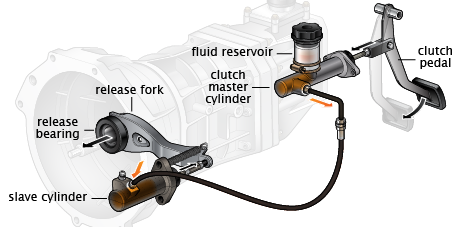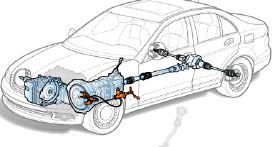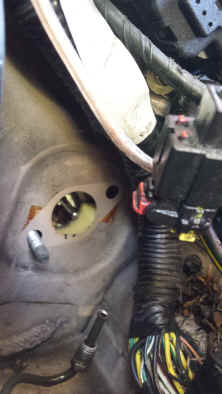

D. Vautier
updated 11/16
 Manual transmission cars today have hydraulic clutches. The clutch pedal pushes on a
master cylinder which drives a piston in the slave cylinder which pushes
the clutch release fork. It's pretty simple. This page
describes some procedures that could be quite helpful to people
unfamiliar with these systems.
Manual transmission cars today have hydraulic clutches. The clutch pedal pushes on a
master cylinder which drives a piston in the slave cylinder which pushes
the clutch release fork. It's pretty simple. This page
describes some procedures that could be quite helpful to people
unfamiliar with these systems.
When the clutch on your car begins to engage too soon it can be a sign of the start of a failure of the clutch hydraulic system. There is an adjustment that can be made in the clutch pedal pushrod but this is an initial adjustment made at installation and may not help. Early clutch engagement can also be caused by a failing slave cylinder. If you examine both cylinders you can probably find out which one is leaking. It would most likely be the master but you have to look for signs of leakage.
I have a 1999 manual Ford Escort. In my case I was
lucky. The clutch began engaging very early so I adjusted the pedal pushrod and got 100 feet
down the road be fore the
clutch failed completely. It was the clutch master
cylinder. A new one cost me $25. My car clutch system shares the
break fluid tank and this is a big advantage when priming.
fore the
clutch failed completely. It was the clutch master
cylinder. A new one cost me $25. My car clutch system shares the
break fluid tank and this is a big advantage when priming.
Master cylinder removal is not as easy as they say because there is a
lot of other stuff that is in the way. So begin with the easy
part, the outside. Remove
the battery and battery tray. Then remove the big outside nut on
the cylinder. Disconnect the brake fluid supply hose at the tank and
use a plug on the brake fluid tank. Next disconnect the hydraulic line with a
10 mm. flair nut wrench, (a misnomer for a hydraulic line wrench, or
break line wrench). If you don't have a flair nut use a vice grip
which will work but will mess up the nut surface. Or get any cheep
six point 10 mm. wrench and grind an opening at the top which also works as a flair
nut wrench. Once
the master cylinder is out remove the fluid hose and put it on your new master cylinder.
From the inside remove the hood cable, clutch switch and fuse box. The fuse box is secured with one bolt way at the top. It then pulls out from a plastic lock bolt in the firewall. The clutch switch may be very hard to take out, two small nuts. Behind all this is the other big cylinder nut. You can feel it but it's very hard to see. Once you can feel it you can get an extension on it and get it out.
Installation is not quite the reverse. First of all remove the hydraulic line clamp from the base of the battery box. You can then easily thread the hydraulic line into the bottom of the new master cylinder. It's very difficult to thread otherwise. Prop up the pushrod with some crumpled paper and place the new unit into the firewall. Put the big nut on finger tight. Now go to the inside and reach around from the passenger side and get the other nut started. Get a socket on it and tighten to spec (real tight). Then tighten the outside nut to spec. Next replace the hydraulic line clamp under the battery box. Finally tighten the hydraulic flange nut under the master cylinder. Inside replace clutch switch and fuse box.

It is almost impossible to get fluid into a master cylinder unless you pre-prime it on the bench or use this other technique, or spend hours pumping the pedal. Fortunately Ford uses the same fluid tank for brake and clutch systems, which means that you can use the hose to force in fluid. It takes two people to do this whereas bleeding only takes one. You need a syringe, preferably 10 ml. The one I used was only 5 ml. and it took about four shots before the cylinder got primed. I filled the syringe with fluid and placed it into the brake fluid hose. My assistant began pumping the clutch pedal slowly. As it was being pumped I applied pressure on the syringe forcing fluid into the unit at each pump. When it no longer took fluid it was primed. I then reconnected the hose back onto the brake fluid tank.
I opened the bleeder valve in the slave cylinder for this step.

Locate the slave cylinder which in my case was to the driver's side of the exhaust manifold. The bleeder valve is just above the hydraulic line. This required me to remove the front heat shield and move it out of the way. I opened the bleeder valve and put a short plastic hose on it. I began pumping the clutch pedal many times until I was able to see some fluid coming out. I then closed the bleeder and began pumping the pedal many more times until I felt enough pressure within the system. I then placed a stick to keep the pedal fully depressed. The purpose here is to have pressure in the slave that should be pushing against the clutch release fork. Opening the bleeder should cause a flow of fluid and air, and should also cause the clutch release fork to move and the slave piston to compress to normal. Do this many times until a clear flow of fluid is observed.

Here is the slave bleeder valve just behind the radiator.

Here is the clip on the hydraulic hose. Remove this in order to easily reconnect the fitting.

Here is a view of the clutch switch and fuse box that are right in the way of the big cylinder nut. These have to be removed.